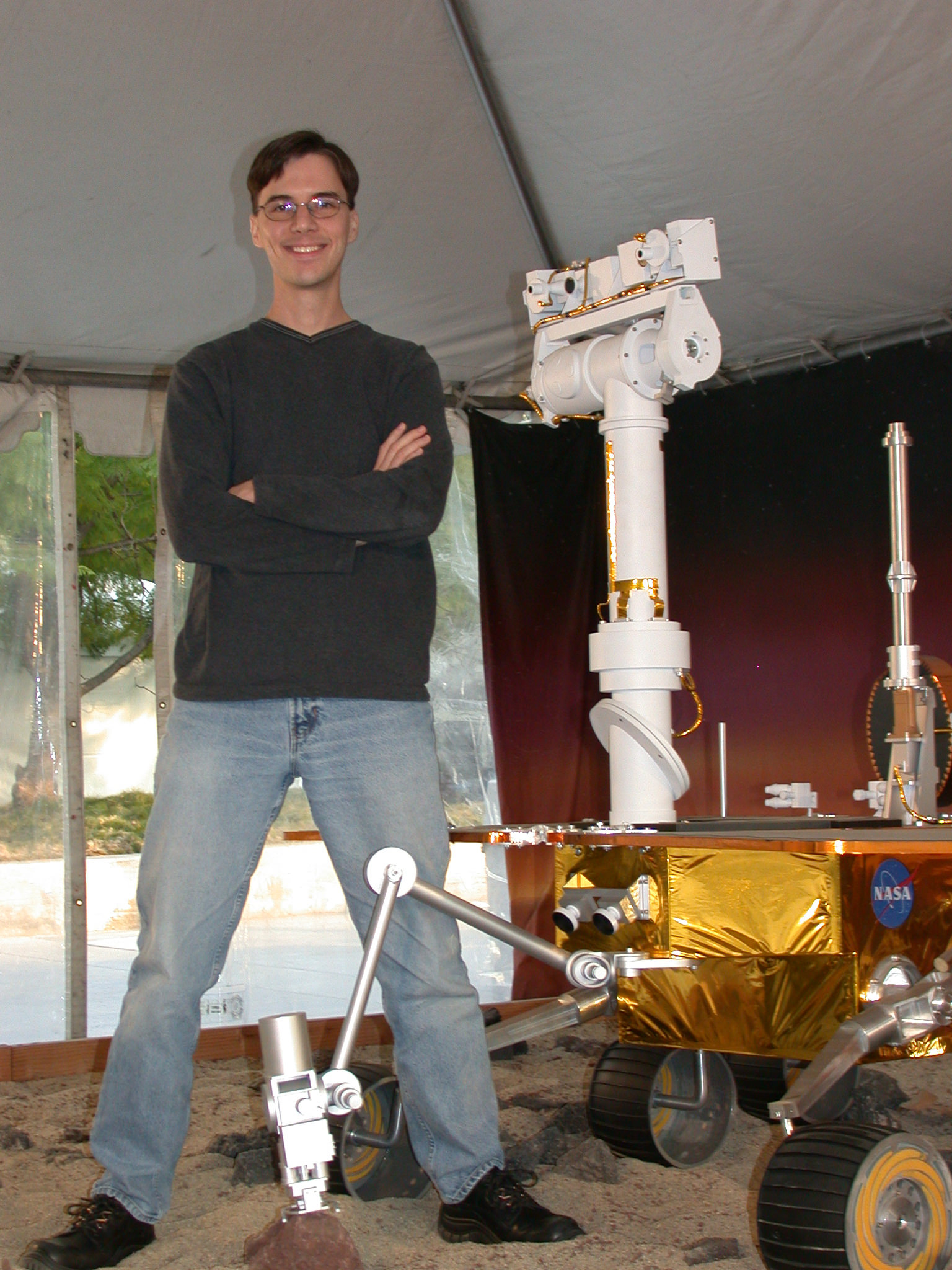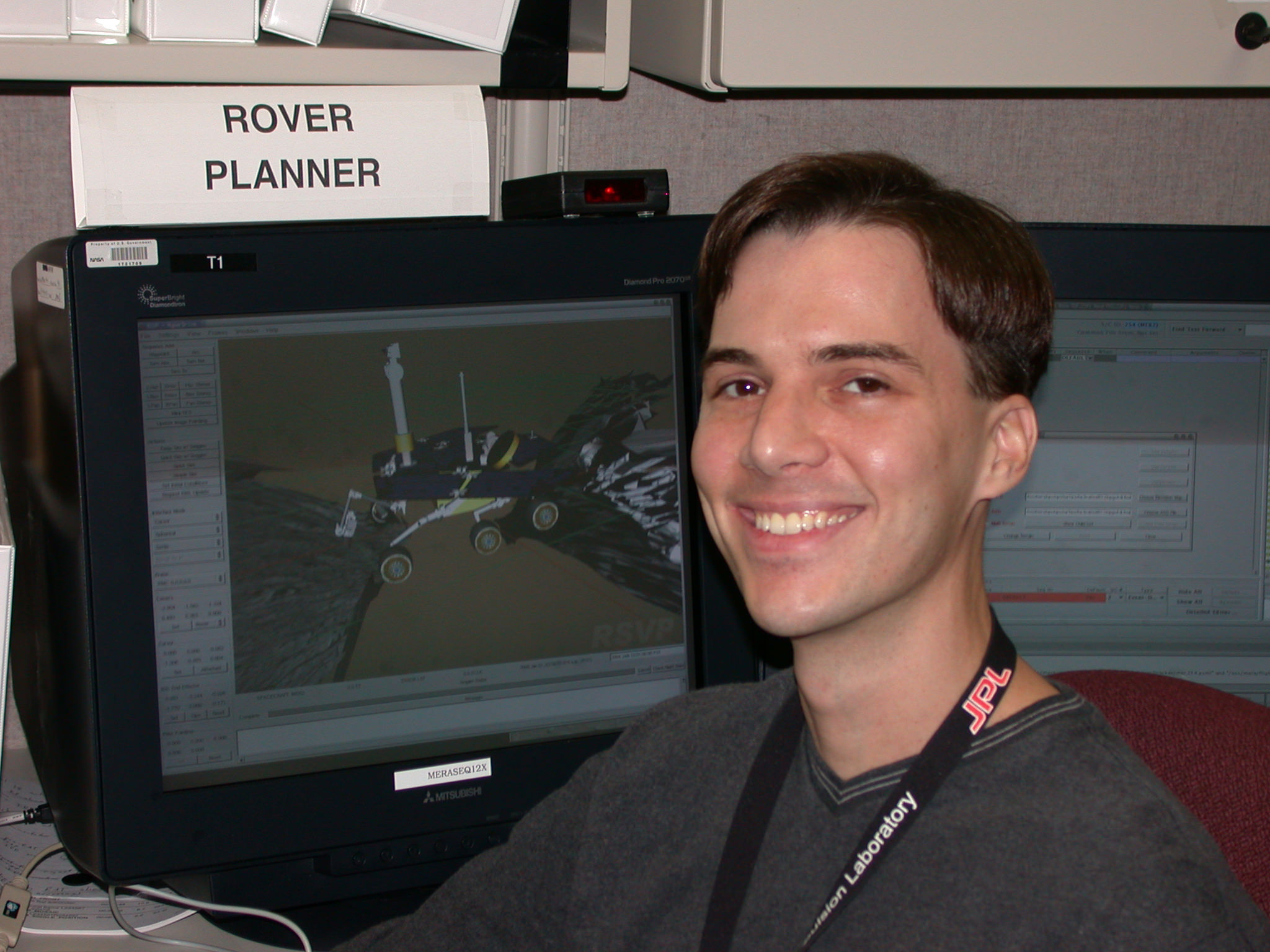Live Hangout Interview with Rover Driver Scott Maxwell
It was history in the making: Our first live interview via a Google+ Hangout On Air! We talked with Mars rover driver Scott Maxwell, and he told us about the plans for the Opportunity rover’s upcoming winter, we took a look back at the 8 years of the MER on Mars, and looked ahead to the Curiosity (MSL) rover mission, set to land in August this year. Thanks again to Scott for being a wonderful first live interviewee!
To watch these interviews live, circle Fraser and watch his feed for updates. If you’re not on Google+, you can still watch these episodes live. Today, we were able to have a live feed on the main page of Universe Today while the interview was taking place (it was on the upper right hand corner). But you can also visit the Cosmoquest Hangouts page and you’ll see them when they happen.
And I’ve got great news: Next Friday, February 17, we’ll have our second live interview with astronomer Mike Brown from Caltech. The interview will take place at 18:00 UT (1 pm EST, 12 noon CST, 10 am PST).
Join UT’s First Live Interview with Rover Driver Scott Maxwell
[/caption]
How often have you wanted to be a fly on the wall during media interviews of top scientists and engineers? Here’s your chance! On Friday, February 10, we’ll be having our first live interview via a Google+ Hangout On Air. We’ve done the weekly Space Hangout for several weeks now and Fraser has done multiple virtual star parties via a Hangout On Air. Now we’ll start the first of what we hope are many live interviews that we’ll share with our readers and fans. We’re excited that Mars rover driver Scott Maxwell, will be joining us, and he will provide insight on the plans for the Opportunity rover’s upcoming winter, a look back at the 8 years and counting for the rovers, a look ahead to the future, and more.
The Hangout On Air will start at 18:00 UTC (1 pm EST,12 noon CST, 10 am PST) or you can check here at the fancy-schmancy time and date announcement Scott put together that shows the time in almost every time zone possible.
How do you find the Hangout? The best way is to join Google+ and “circle” Fraser and the Hangout On Air will show up in his timeline. You can also circle Nancy, who will also provide a link, but within Fraser’s timeline there will also be the opportunity for you to post questions that we can ask Scott during the live interview.
If you can’t watch live, the Hangout will be recorded and we’ll post it later on Friday on Universe Today.
We hope you’ll join us!
Wind Gust Gives Opportunity Rover a Power Boost
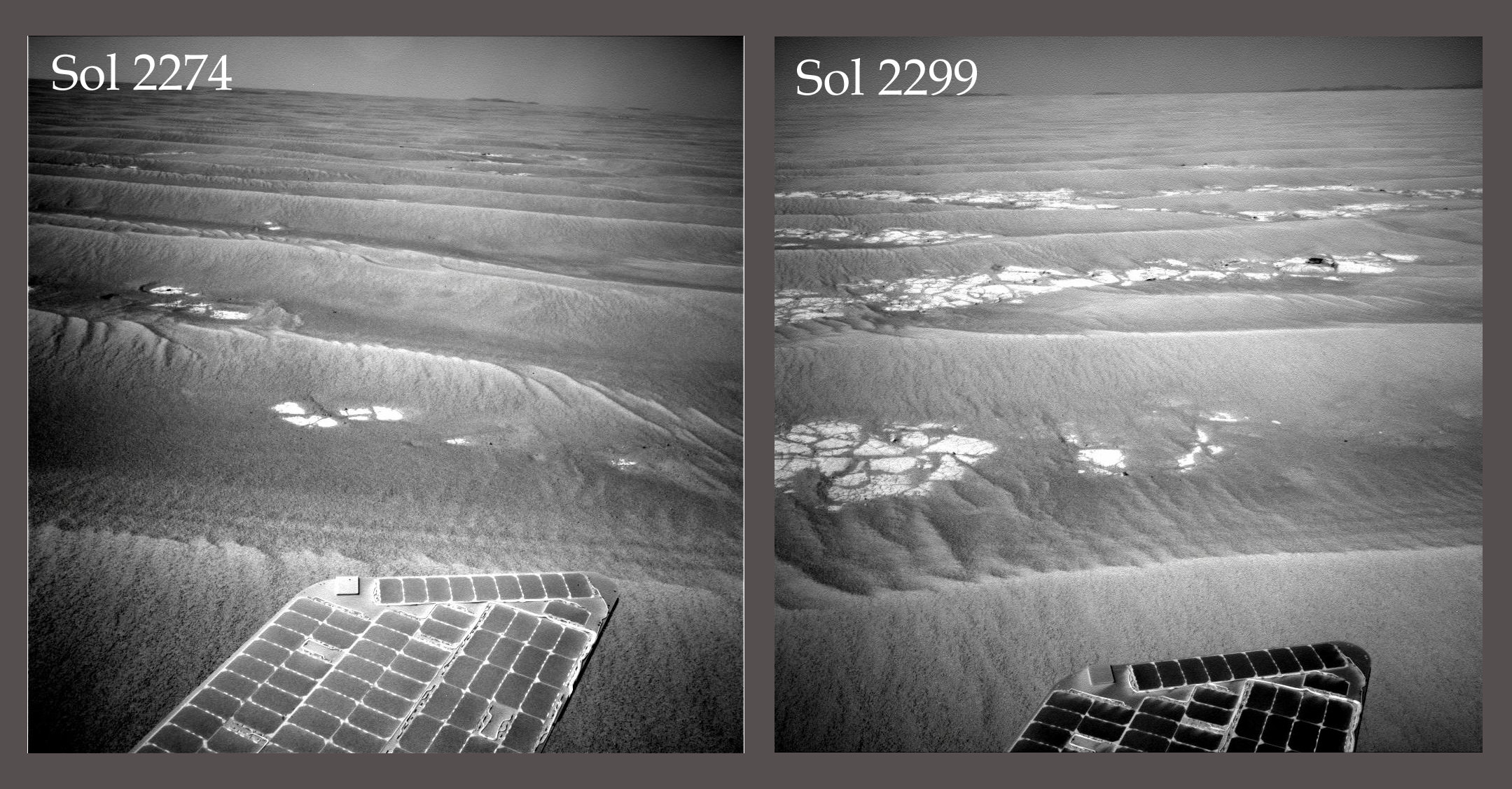
[/caption]
Either some little Martians came by and gave the Opportunity rover a quick once-over cleaning, or a recent gust of wind blew layers of dust off her solar panels. The image above (supplied by our favorite photo- whiz Stu Atkinson), shows Oppy’s solar panels on sol 2274 and 2299 (approximately June 18 and July 12 here on Earth) with a marked difference in the amount of dust on the panels. Yesterday, the Twitter account for the rovers, @marsrovers Tweeted: “Love those Martian dust busters! A recent wind gust cleaned Oppy’s solar panels giving her a little power boost for the road.” And on the road she is, heading earnestly for Endeavour Crater, with several recent drives of around 70 meters (230 feet) per sol. But she now has some new autonomous software the rover team is trying out, and with her new greater power capacity, she should be able to keep on truckin’. Mars rover driver Scott Maxwell reported on Twitter this week that Opportunity is 40% of the way from Victoria Crater to Endeavour.
And what’s the latest news about Spirit – still silent?
According to Maxwell (again on Twitter), the power models for sunlight hitting Gusev Crater say the very earliest we could possibly hear from Spirit could be sometime late this week. But he added that more likely would be hearing from Spirit by around mid-November.
But catching Spirit awake is complicated, with timing being everything. “Even if Spirit’s waking up (soon), we’ll have a hard time catching her during one of her wakeups,” Maxwell said. “This will take some luck as well as skill,” having the Mars Reconnaissance Orbiter or Mars Odyssey overhead and listening at the very moment Spirit is talking. Maxwell added that the team is working on how to locate Spirit if she’s had a Mission Clock fault and doesn’t know how to send communications to Earth.
It is very likely that Spirit has experienced a low-power fault and has turned off all sub-systems, including communication and gone into a deep sleep. While sleeping, the rover will use the available solar array energy to recharge her batteries. When the batteries recover to a sufficient state of charge, and if the Mission Clock hasn’t gone completely bonkers, Spirit will wake up and begin to communicate.
Spirit’s odometry remains at 7,730.50 meters (4.80 miles).
But meanwhile, Oppy’s total odometry is 21,550.77 meters (21.55 kilometers, or 13.99 miles), and she’ll be putting on more as she heads towards Endeavour Crater. Maxwell later said he has an idea to speed up the rover’s drives as much as 30%, so that will be interesting to find out more about his idea. “A 30% speedup would shave 2-3 months off our trip to Endeavour — maybe even more than that. Worth a try! Phyllosilicates, here we come!,” he tweeted, referring to the water-based minerals that scientists are hoping to find within the crater. That would mean water helped form the rocks in Mars’ early history.
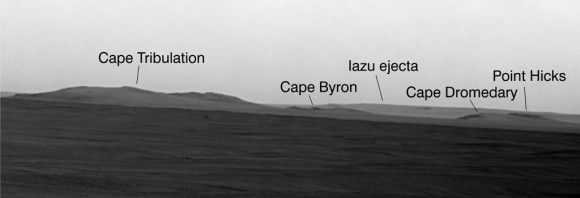
Speaking of Endeavour, recently, NASA and JPL released an image showing the newly-given names of different points on Oppy’s next destination, and there’s a push by some people in Australia for one additional feature to be named “Nobby’s Head.”
The rover team is using the theme of names of places visited by British Royal Navy Capt. James Cook in his 1769-1771 Pacific voyage in command of H.M.S. Endeavour. My friend Col Maybury from radio station 2NUR in Newcastle, New South Wales, Australia is helping to promulgate this request to NASA, with the support of the Minister of Tourism and Newcastle’s Lord Mayor. “Hopefully we will get a favourable reply soon,” Col wrote me.
Cook first came to this location in May of 1770. At midnight by moonlight he saw an island jutting up from the sea and wrote in his journal: “A small round rock or Island, laying close under the land, bore South 82 degrees West, distance 3 or 4 Leagues.”
Now called Nobby Head, it is the entrance of Newcastle Harbour, formed by the Hunter River, a great coal port of New South Wales. The feature on Mars is the same shape as Nobby Head on Earth. Wish Col and the people of Newcastle good luck in their “endeavour” to name this feature! (Anyone from the rover team naming committee reading this?!)
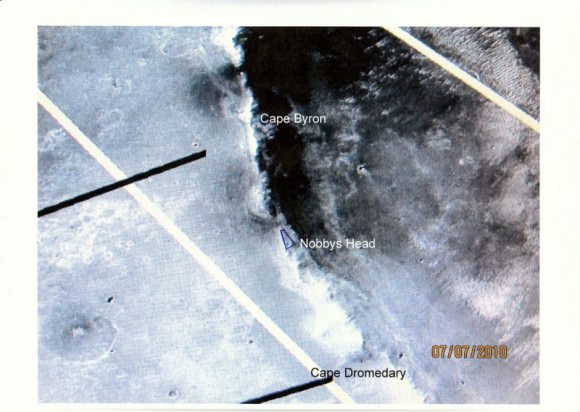
And don’t forget, Friday July 16 is Mars Day! The National Air and Space Museum has some ideas on how to celebrate.
How to Drive a Mars Rover, Part 3: Five Years on Mars
[/caption]
In preparation of celebrating Spirit and Opportunity’s fifth anniversary on Mars in January, we’ve been talking with rover driver Scott Maxwell, getting updates on the two Mars Exploration Rovers and learning about what it really is like to drive the rovers. Today, Scott will share some of the highlights of the past five years, and his outlook for the future. But first, in the latest updates from Scott via Twitter, he says Spirit tried to back-up off of ‘Home Plate’ but encountered quite a bit of slippage. It looks like she’ll probably end up driving forward and taking the long way around the low plateau to the next target objects, a hill called Von Braun, and a crater-like feature nearby called Goddard. Meanwhile, Opportunity is studying “cobbles” or loose rocks at a region called Santorini, where she has been stationed during solar conjunction. Now that radio transmissions are improving, Oppy will start receiving commands from the rover drivers to hit the road again. The image above is a panoramic image of Santorini, put together by James Canvin at his website, Martian Vistas.
Scott has actually been with the MER mission for longer than just the five years since the rovers landed. He joined the team early on, about three-and-a-half years before the rovers launched. He was part of the development team, helping to write the software used to drive the rovers. Back then, did he ever fathom the rovers would last this long?
How to Drive a Mars Rover, Part 1
How to Drive a Mars Rover, Part 2
“I think back, to that time, and we did all that work where we sat in our cubicles, had meetings and argued with each other about the best way to program the software,” said Scott. “We slaved away working on the mission, never knowing if the mission would succeed or not. We did all that work just for the chance, the hope, that the rovers would be working on Mars for three months. And it was worth it.”
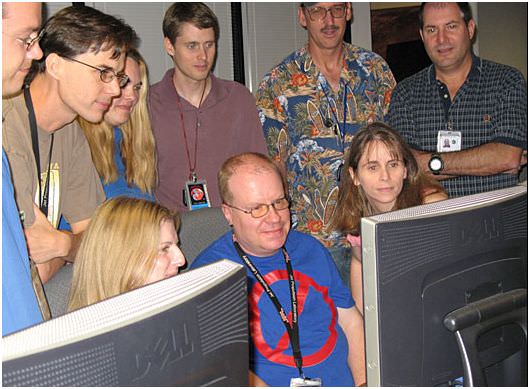
“And then to do all that work and have the rovers on Mars for five years, it’s like you’re playing a slot machine and you put in your quarter and pull the lever, and not only do a few quarters come out, they keep coming and coming and coming, and it fills up your cup, and overflows. That’s what it’s like to work on this mission.”
OK, Scott, now we want to know the highlights for you from the past five years. Certainly there’s at least one or two memorable moments!
“Certainly for me, there are two things I think of,” Scott said. “One is the first time I ever drove the rover. There was the period early on where we lost contact with Spirit. But then we were able to recover her. But that was a month into the mission where we thought it was only going to last three months, and it delayed the time until I got my first chance to drive her.”
“I still remember the day. We planned and planned and rehearsed the drive. I checked over the sequence a million times before sending it. Then I went home and I should have gone to sleep, but I couldn’t. I just laid there in my bed and stared at the ceiling, and couldn’t get past the thought that right then, at that moment, there was a robot on another planet, doing what I had told it to do. It was just an awesome feeling to imagine that, and that feeling has never left me. I still feel like that every time I drive the rover.”
Scott says it’s an incredible feeling to go outside and look up and see Mars in the sky, and on that red dot way out there is an object, placed there by humans, and humans are telling it what to do. “And I’m one of the people doing that. It’s an absolutely amazing feeling. I feel that way all the time.”
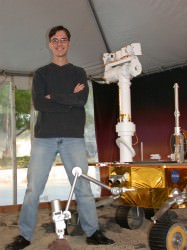
Its obvious Scott has a soft spot in his heart for Spirit, as another memorable aspect of the mission involves her, too. Scott tells the story so well and with such passion, I’ll just let him go:
“The other thing I always think about is that Spirit travels the 300 million miles to Mars, she gets to Mars, drives off the lander, and she’s gone all that way with the hope of finding evidence of past liquid water on Mars,” Scott said. “But instead, when she drives around, there’s nothing: just lava as far as the eye can see. She drives around the area and looks at rocks, and then drives over to Bonnevillle crater, which is her best chance of finding evidence of liquid water, thinking maybe if she goes down far enough into this crater there will be something there, but there’s nothing.”
“But way off in the east, there are a range of hills, the Columbia Hills, and (principal investigator) Steve Squyres says clearly the hills may be too far for us to get to, but maybe we can get some images that can tell us something. But Spirit takes off for those hills anyway, even though they are too far away, and never gives up and gets there; she actually makes it all the way to the bottom of the hills.”
“And then,” Scott continued, “she’s at the bottom of the hill, looking up at them, and it’s now twice as long as she should have survived and she has driven three times as far as she was supposed to be able to drive, and she’s tired and her wheels are sore, now is when the real challenge will begin. Now she won’t just be driving over flat terrain, like she was meant to drive on. She’s going to have to climb the hill, which is taller than the Statue of Liberty, and everyone thinks it’s way too tall for this poor little rover to climb. But she does it anyway.”
“She starts climbing up the hill and there are times when she can’t make any progress, so we have to turn her around and give up some of the altitude she’s won and go back and find another path, but she never gives up and goes all the way to the top of that hill that was just impossibly far away when she started.”
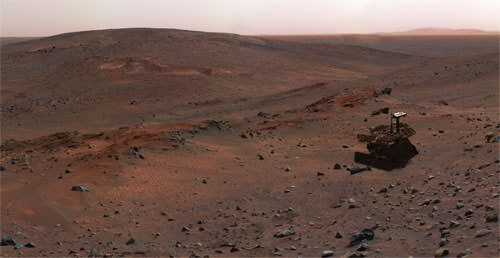
“When we came into work that day and we saw that image of Spirit standing on top of Husband Hill with the beautiful panorama of the world around her –she stood there for a long time and took the images of the area around her — to me, that’s one of the achievements, not just of this mission, but of engineering excellence in our whole civilization, to be able to do that. To be able to go so far and do so many impossible things, that image just says all of that for me. I know what it took to get there and be able to take that image, and I feel the pride of being part of the team that made it happen. It is just an amazing experience.”
As incredible as the MER mission has been, we all know the rovers won’t last forever. Someday – and we don’t know when – the rovers will eventually quit working. It’s hard to think about life without the rovers, but has Scott given any thought to what mission he would like to work on next?
“It’s all downhill from here!” Scott laughed. “But, really there’s a lot of cool and exciting stuff going on at JPL. We’ve got another rover we’re working on, the Mars Science Laboratory, and I’ve been working on that. I’m also involved with ATHLETE, which is a 12-ft. tall six legged robot spider on roller skates that we are going to send to the moon. There’s always so much like that going on here at JPL, it’s just like being an engineer in Disneyland. You come to work and say, ‘What cool stuff can I work on today?’ It’s just awesome, and there’s just no end to it.”
Scott says he has nothing against orbiter missions, but to be honest they’re not top on his list. “I’m not putting them down,” he said, “but orbiters don’t really float my boat. I kind of get into rovers, I kind of relate to them, in a way. But you look at a mission like Cassini and it’s amazing! Cassini is finding liquid water spewing out of Enceladus, and dropping a probe onto Titan and getting the first view beneath the thick clouds that cover that moon! It’s just amazing stuff. So even though orbiters aren’t my thing, I might end up on one of them, too, you never know.”
Scott has definitely shown his worth with the rovers, so, even though the MSL launch has slipped to 2011, the rover fans out there are secretly hoping Scott will have a place on the MSL team when the time comes.
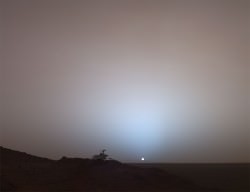
But in the meantime, Spirit and Opportunity, the Energizer Bunnies of Mars exploration keep going and roving, and sending back loads of data and images.
JPL has put out a video to celebrate the rovers’ five years on Mars, where Scott says it best: “It seems like every day is better than the day before. The mission keeps getting better and better the longer it goes.”
Happy birthday Spirit and Opportunity! We’ll take as many years as you can give us!
How to Drive a Mars Rover, Part 2
[/caption]
The Mars Exploration Rovers have been traversing the surface of the Red Planet for almost five years now. But how exactly are the two rovers, Spirit and Opportunity, “driven” from Earth, about 150 million km away? Many of us might have visions of joysticks, similar to what are used for remote control toys, but it’s not like that at all. However, being a “Rover Driver” is one job where having experience with video games and simulation software looks good your resume! Scott Maxwell is one of fourteen rover drivers, or planners as they are also called, who last week gave us an update on Spirit and Opportunity’s status. Today, Scott provides the details of how to drive a Mars rover.
“The way we wished it would work,” said Scott in a phone interview from JPL, “is if we could have a joystick where if we pushed forward on the joystick the rover would go forward, or push back and the rover would stop. But, with lag time delays in the radio signals, you would push forward on the joystick and 10 minutes later the rover would get the signal to go. But on Earth, you won’t know if it worked for another 10 minutes after that because of the time it takes for the signal to get back to you.”
This would create a nightmare in logistics, planning and operations, because the drivers can’t “see” what the rover is doing in real time. So instead, the rover drivers work the Martian nightshift.
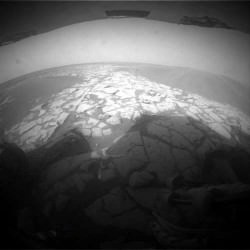
“We take advantage that our solar powered rovers have to shut down for the night,” said Scott. “So as the sun is going down in the Martian sky, the rover is commanded to take pictures of the world around them and send it before they go to sleep. When we get that data back on Earth, we go to work. We take all the images and put them into a simulation. We have a 3-D simulation world — kind of like a video game — on our computers. Then, we have a simulated rover that we put down in that 3-D world and we drive that rover around instead.”
So in that 3-D world, the rover drivers can test every possibility, make all the mistakes (tip the rover, get stuck, drive off a precipice, crash into a big rock) and perfect the driving sequence while the real rovers are dozing securely and peacefully. This certainly has helped with the long life the rovers have led, as in five years the rover drivers have safely and successfully guided the rovers to drive in and out of craters, climb a challenging hill, and put on more mileage than anyone ever thought possible. The biggest driving calamity has been getting stuck in a sand dune, but now the driving team has a few tricks up their sleeves to avoid that (see Part 1).
So then, when the drivers perfect the commands inside the simulation and hone the exact sequence of movements for the rover, they upload those commands and send it to the real rover. Then as the sun is coming up on Mars, the rover wakes up, receives a communications uplink from Earth, processes the commands and it goes to work while the rover drivers go to sleep. “At the end of the rover’s day, it sends us more pictures and data, and we start the cycle all over again,” Scott said.
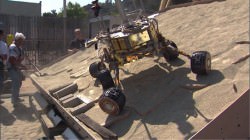
If there’s a particularly difficult situation, such as how much tilt can the rover withstand without tipping over, a test rover can go through the same sequences in a simulated Mars environment out in JPL’s Mars Yard.
Back in 2004 during the “prime mission,” the first three months of the mission (the original length of time the rovers were slated to last) everyone who worked with MER lived on Mars time. Since the two rovers are on opposite sides of the planet, that meant operations going on 24 hours a day. And since a Mars day is 40 minutes longer than Earth’s day, that meant a perpetually shifting sleep/wake cycle, a difficult situation where your body continually feels “jet-lagged.” But now that the mission has been ongoing for such a long time, the planners operate in a more Earth-normal mode and even take some weekends off. But still, a planner’s eight- hour shift can start anywhere from 6:00 a.m. to noon.
So what’s an average drive for the rovers? “It varies widely,” Scott said, “but an average drive is in the neighborhood of a few meters.” Right now Spirit is struggling her way up the side of “Home Plate,” a low plateau, which for a rover is a steep hill. The crumbly soil gives out beneath her wheels as she makes the climb, making it difficult to drive father than a few centimeters in a day. Plus, Spirit is dealing with low power levels from dust-covered solar panels, providing limited energy for any big drives. Just after a recent dust storm, Spirit’s solar panels were producing only 89 watt hours, which is about the energy needed to run a small light bulb for an hour and half.
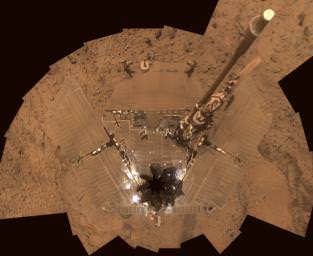
But Opportunity’s power levels are much better, and she recently had drives as long as 216 meters, as she puts the pedal to the metal in an attempt to reach Endeavour Crater, about 12 km away.
Some of the rover drivers work mainly with one rover (Steve Squyres has said it’s easy to get attached to one rover or the other, depending which one you’re working with) but Scott goes back and forth between the two. “That’s in part because I’m a team lead, and part because I’m the kind of person who wants to run around and be part of everything all the time!” he said. When we talked with Scott last week, he was working with Spirit, and thought that this week he will probably do a drive or two with Opportunity.
Currently Spirit’s total odometry is at about 7,530 meters (over 4.6 miles), while Opportunity’s odometer reads almost 14,000 meters (about 9 miles).
JPL has some wonderful videos of the rover’s treks, travails and progress, and you can keep track of the rovers’ progress by checking for regular updates on the MER website.
Tomorrow: What have you been doing the past five years? Scott Maxwell shares what five years of driving the Mars rovers has been like.
How to Drive a Mars Rover, Part 1
How to Drive a Mars Rover, Part 3
How to Drive the Mars Rovers, Part 1: Rover Updates
[/caption]
In January of 2004, NASA’s twin robot geologists, the Mars Exploration Rovers Spirit and Opportunity, landed on the Red Planet. During those nearly five years, the rovers have returned hundreds of thousands of images and enough data to keep scientists busy for decades. But almost nine years ago, Scott Maxwell started working on developing software and techniques for driving the rovers around on Mars surface. Today he’s the Mars Rover Driver Team Lead for MER at JPL, and he says that every day of working on this mission has been incredible. “It’s been an amazing experience,” he said, “and I like to say it’s the best job on two planets.” To celebrate the upcoming fifth anniversary of the rovers on Mars, Universe Today caught up with Scott to get an update on the current status of the two rovers, to find out what the five-year MER mission has been like for a rover driver, and to ask the pressing question, just how do you drive a rover from 150 million kilometers away?
Both rovers have been inactive recently because of solar conjunction, where the sun is between Earth and Mars, which makes communications difficult because the amount of radio noise generated by the Sun. So, when I talked to Scott on Wednesday of this week he was just working on the commands that would be sent to Spirit for the first drive she has taken since several weeks ago. So how is Spirit doing these days?
“Spirit is struggling valiantly to climb up the north face of Home Plate,” Scott said. “As you know, we’ve just come out of solar conjunction, and so we’re picking up where we left off on Spirit’s climb up the face. Her solar array energy levels are not as good as they were before the mini-dust storm we had before the conjunction, so that’s obviously a cause for concern. It’s unfortunate because that means we have less energy for driving. But she’s still alive and that’s a lot better than what we thought she’d be five years into the mission.”
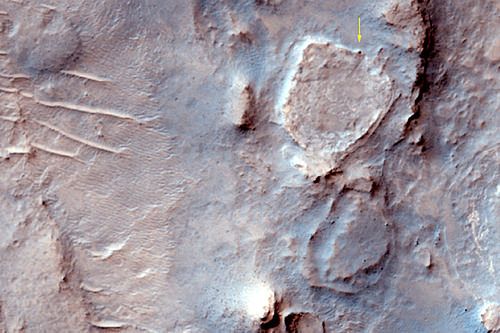
Home Plate is a low plateau about 80 meters (260 feet) in diameter. Spirit spent the Martian winter parked on the north side of the plateau with her solar panels slanted towards the low sun in order to stay alive. But Spirit’s solar arrays are severely dust-covered, decreasing the amount of power available for science activities and driving. But the scientists and engineers haven’t given up on Spirit, and still have big plans for her.
“Our longer term goal is to head south from Home Plate to a pair of features called ‘Goddard’ and ‘Von Braun’,” said Scott. “Von Braun is a hill and Goddard is a crater-like feature next to it, and that’s the next area we’d like to explore. As you know, the area around home plate appears to be a region of past hot-springs or volcanic fumarole activity, the kind of place where life might have formed on Earth, so it makes it a particularly exciting place to explore on Mars, as we try to find out more about what was going on here.”
But ‘Goddard’ and ‘Von Braun’ are on the south side of Home Plate and Spirit is on the north side. The easiest route would be to “climb back up on the top of Home Plate and kind of skate across it where the driving is good” Scott said, but if Spirit isn’t able to make the climb, they will drive down the north slope and go around Home Plate the long way. But that might take more time, and time might be getting limited for Spirit.

So, the shortest way is up and over Home Plate. But Spirit has a bum right front wheel, and is trying to climb up some difficult terrain. “Imagine you’re in the desert, climbing up a sand dune, but every step you take the sand crumbles out from beneath you,” said Scott. “That’s what Spirit is experiencing. So even though we’re commanding the wheels to go several meters, she might only make a few centimeters of progress in a sol (Martian Day).”
But the driving team will keep trying, as ‘Von Braun’ and ‘Goddard’ are of interest to the science team.
Opportunity, on the other hand, is in very different driving conditions. “Right now she’s basically on a parking lot, with only a couple of speed bumps every once in awhile,” Scott said. “Opportunity can drive 100 meters a sol, like the length of a football field every day, without breaking a sweat. We recently had a nearly record-setting drive, with Opportunity where we drove nearly 216 meters in one day,” Scott said proudly. “So that’s our silver medal drive, our second longest drive ever with either of the rovers.” (The longest drive was 220 meters in one day.)
One thing Opportunity does have to watch out for is sand dunes in the region. In 2005, Opportunity became stuck in one of those dunes, and it took the rover driving team over a month to figure out how to maneuver Opportunity out of the sand trap, called Purgatory Dune. In honor of the difficulties and lessons learned from getting stuck, all the potential sand traps in the region are called “Purgatoids.”
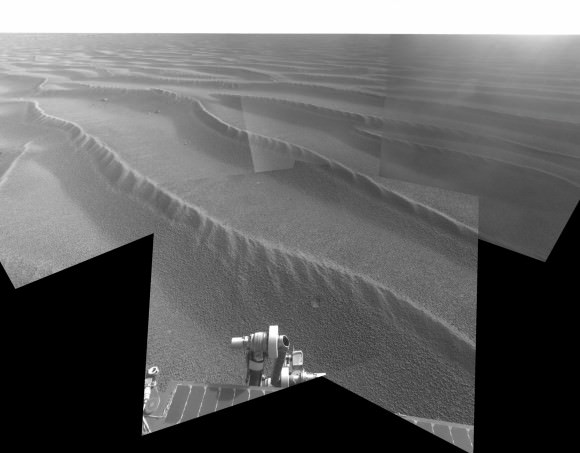
“Opportunity is in a region where Purgatiods are all around her.” Scott said. “But the good news is that we have better data now, than we did when we first encountered these features.” The MER team now has the benefit of the Mars Reconnaissance Orbiter’s HiRISE Camera in orbit around Mars, looking down at — if not watching over – the rovers and their activities. “So we have the data and images from HiRISE, and we think we have identified a way to pick out these Purgatoids from orbit.” Scott said. “So we take the images from MRO, and use them as part of our path planning for Opportunity every day, and also for our longer scale path planning. On top of that we have other measures we have adopted after that first Purgatory incident, where the rover stops every once in awhile and ‘checks’ itself, gauging whether it is actually moving or if it is stuck and the wheels are just spinning. So even if we get into a Purgatoid, we’ll be able to catch it before too long and have the chance to get ourselves out before we dig in too far.”
But so far, with the new technique of being able to identify Purgatoids from orbit, Opportunity hasn’t run into a single one.
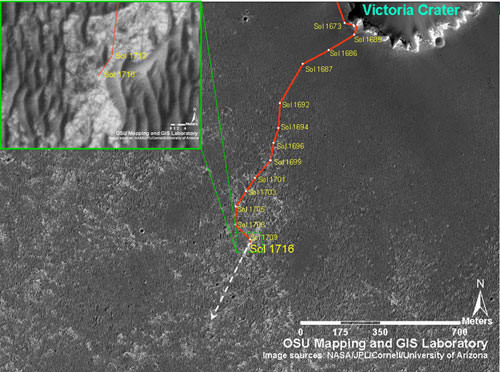
“It makes us happy to put the pedal to the metal and just drive,” Scott said, “It’s a lot of fun.”
Opportunity is “putting the hammer down” to reach a crater about 12 kilometers (7 miles) away called Endeavour. The huge crater is 22 kilometers (13.7 miles) across, and scientists expect to see a much deeper stack of rock layers than Opportunity saw while she was in Victoria Crater the past two years. The 12 km driving distance would match the total distance it has traveled from 2004 to mid-2008. Even at the 100-meter plus pace each sol, the journey could take two years.
But Scott Maxwell and the 13 other rover drivers working on the MER mission are up for the challenge.
Tomorrow: Part 2: Just how do you drive a rover on another planet?
How to Drive a Mars Rover, Part 3

